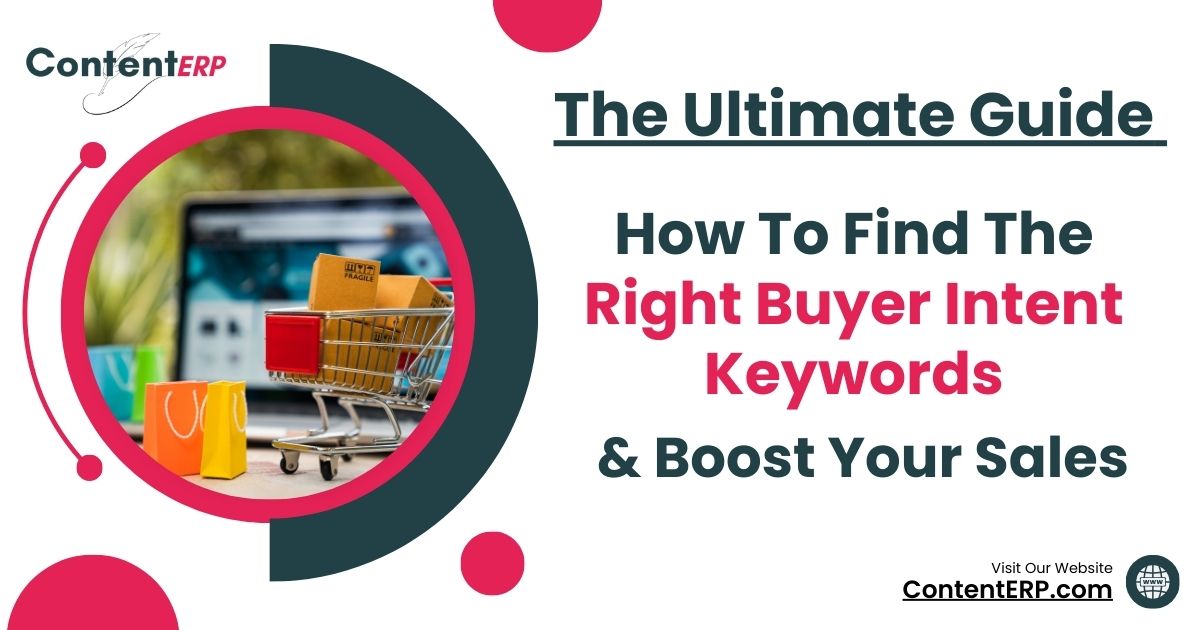Here’s a crucial fact for your business that you won’t be able to ignore: over 50% of shoppers use Google to know more about the product and its feedback before buying. So how can you unlock the hearts – and wallets – of those customers who are constantly thinking with Google? Enter the secret passcode: buyer intent keywords.
In this digital world, your brand’s success is defined by the keywords you target. Jeff Bezos once said, ‘Your brand is what other people say about you when you’re not in the room.’ And to build that kind of presence, you first have to have the audience find your brand and buy your product. That’s where buyer intent keywords come in to act like signposts & milestones to guide them towards you.
This ultimate guide will tell you what buyer intent keywords are and how you can find them in our highly competitive digital marketplace to revolutionize your sales and engagements. Let’s get started.
What is Buyer Intent and Why is it Crucial for Your Business?
To help you understand in the simplest of words, buyer intent is the “why” behind searches and clicks of your audience. It represents the level of desire or curiosity of the buyer towards any product. Buyer intent is what differentiates between someone who’s merely browsing and another who’s ready to buy something.
This understanding of the user intent gives you a crystal ball that can show you what your potential customers are actively thinking and gives you a path towards those who are not only interested but looking to buy your product.
Why is Buyer Intent Crucial?
Here’s why buyer intent is absolutely crucial for your online business:
Directs Your Strategy & Increases Conversions
When you focus on buyer intent and then target high intent keywords in your marketing efforts and content calender, your marketing efforts will become more targeted instead of generic. This will help you improve your efficiency and conversion rates in the longer run.
Optimizes Spending & Increases ROI
Losing money pointlessly without results is the last thing you’d want in your marketing efforts. With the right buyer intent, you can maximize your ROI because every dollar you’ll spend is used to attract a highly interested audience.
Improves Customer Experience
When you create content according to your buyer intent, the potential customers will be able to find the information or products they search for. This increases their chances of interaction with your brand.
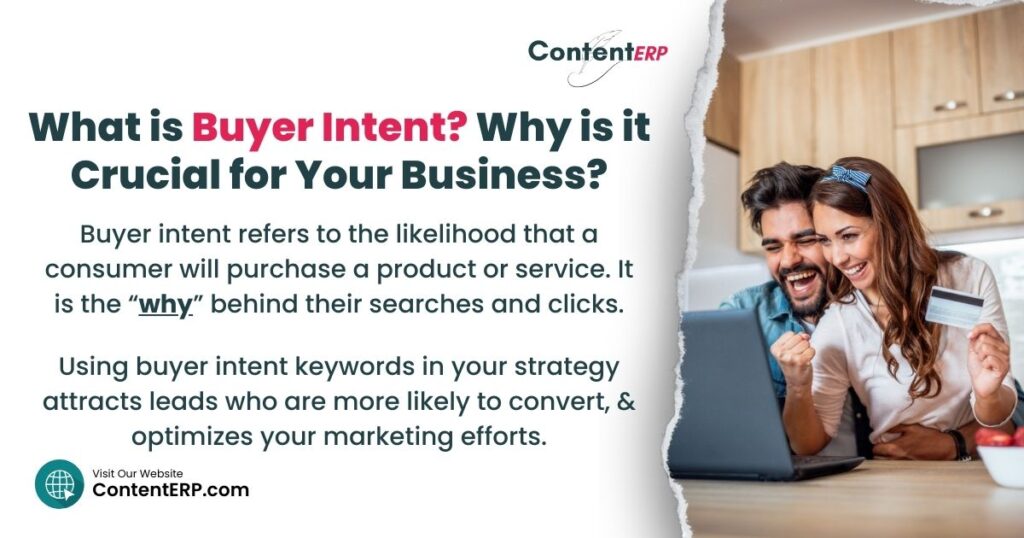
How Can High Buyer Intent Keywords Transform Your Sales Strategy?
Imagine you are in the mood for prawn soup or fried prawns and you go fishing to catch some. How would you feel if you kept catching sunfish or eels instead? Frustrated, right? Maybe you are not using the right kind of nets.
Now take this analogy to the the online world. High intent keywords are the perfect nets that will help you catch only prawns. They will help your marketing efforts become much more effective because they help you speak directly to those who want to buy and increase your close rate from 1.7% to 14.6%.
So notice how effective they can be to transform your sales strategy.
Understanding Buyer Intent – What are Buyer Intent Keywords?
To explain the concept of buyer intent, we have to know about the language of conversion: the buyer intent keywords like ‘discount’, ‘review’ and ‘best’ etc. These words are usually used by combining them with supporting words/product or brand names/dates, for example ‘Puma shoes review’, ‘best phone in 2024’ etc.
Don’t think of them as simple words, they are specific phrases instead that different types of buyers and searchers may use when they are close to buying something. They show that the buyers are interested in buying the products and not just review or know more about them, hence highlighting their buying intent.
So when you use these keywords in your content strategy, social media posts, SEO and ad campaigns, you’ll attract those consumers directly towards your products.
What Are The Types of Buyer Intent Keywords?
On the most basic level, there are four types of buyer intent keywords that can explain the purposes of search in a buyer’s purchase journey.
1. Transactional Keywords
These are the clear-cut “I want to buy” phrases and keywords that people use, such as “buy,” “discount,” “deal” or “coupon.”
2. Commercial Investigation Keywords
Buyers usually use them when the intent behind them is to compare options, look for the best solution or decide between products. They include phrases and words such as “best,” “review” or “top.”
3. Navigational Keywords
They may not point towards an immediate purchase but show that a user is willing to know more about a specific brand or product. They include exact terms/brand or product names like “Nike running shoes” or “MacBook Air price” etc.
4. Informational Keywords
These words show that the people are looking for some information on the topic/product/service etc, like “what”, “how”, “guide” etc. Based on them, we can safely assume that they may be interested in buying that product or service at a later time.
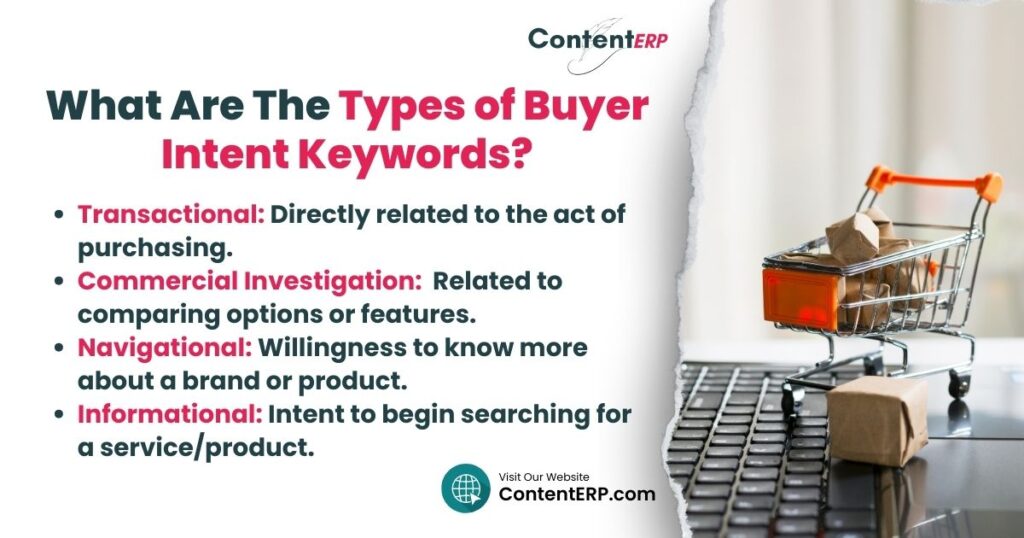
Why Should You Target Buyer Intent Keywords?
“Why should I care about buyer intent keywords?” You might convince yourself that you are doing absolutely ok otherwise. But by not using those keywords, you are not fulfilling the basic aim of your marketing which is to know and understand the customer so well that your product or service fits them and sells itself, as Peter Drucker has highlighted.
Here’s why you should use as many types of buyer keywords as possible in your marketing efforts:
1. Targeted Keywords Increase Your Conversion Rates
When you use keywords with buyer intent like “buy now,” “discounts” or “free shipping” in your SEO content and ads, you basically put up a sign for your audience that says, “Right this way for your needs” and guides them towards your product or service.
This approach also helps you to filter out those who are not looking for you and targets only those who are looking for what you offer. This is supported by the study from Forrester that customized landing pages – which often include those targeted keywords related to buyers – can increase your conversion rates by over 200%.
2. High-Intent Keywords Are Crucial For Long Term Sales Growth
Sales are not about more visitors, they are about the right visitors. High intent buyer keywords in your content and digital brand strategy will specifically target those who aren’t just browsing but looking for a solution that you might be able to offer.
Here’s an example to help you understand: Consider the difference between “how to fix a leaky faucet” and “professional plumber services.” The second phrase, in this example, is a high intent keyword that speaks to an audience that may have already tried the DIY route and now wants to hire a professional. This is what will guide that audience to you if you offer those services and also use that keyword in your marketing efforts.
3. Intent Keywords Help Maximize ROI
Your investment in keywords is part of your marketing budget. And like any investment, you want the highest possible return, right? Keywords, especially the commercial intent keywords, are your answer here.
Google says that at least 50% of the consumers visited a store within a day after conducting a local search and 88% did within a week. See how important it is to target the local and commercial keywords for businesses?
These keywords usually have a purchase-ready intent and can include words like “best price on,” “cheapest” or “coupon code for” and try to convince your customer to purchase as soon as possible before that offer runs out.
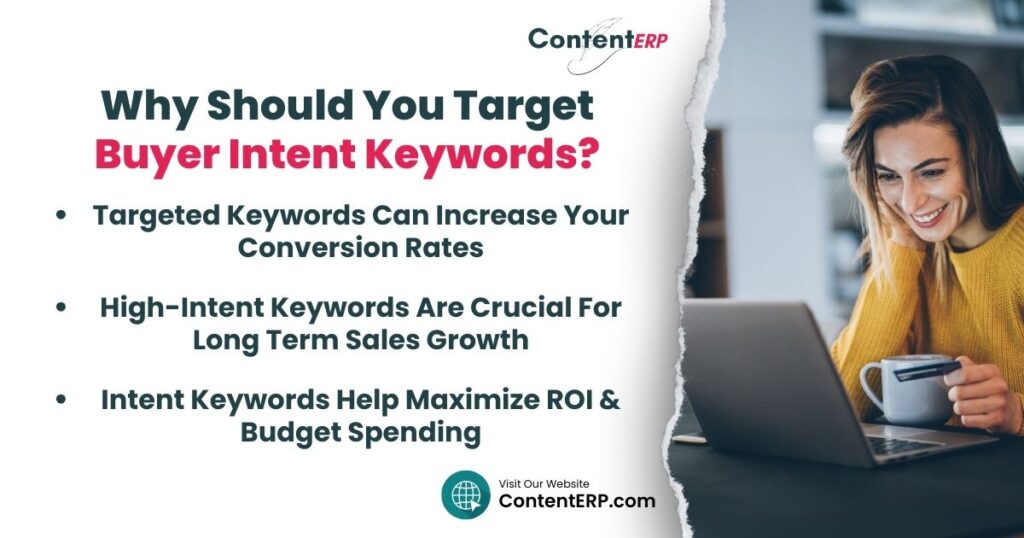
How to Find High Converting Buyer Intent Keywords
Leonardo da Vinci once said “Simplicity is the ultimate sophistication.” This is what should become the starting point when you begin your search for the most effective keywords that drive sales. Let’s uncover the best strategies to help you find out the best buyer intent keywords to capture the attention (and wallets, of course) of your ready-to-buy customers.
Use Keyword Research Tools To Know The Purchase Intent
The very first thing that you should have by your side is the keyword research tools and a strategic approach. Tools such as SEMrush, Ahrefs and Moz offer you some in-depth keyword analytics and details to help you know about their search volume, competition level and keyword difficulty etc.
How to use the keyword research tools effectively:
- Start with Seed Keywords: Find keywords with broad terms that may be related to your products or services directly. Once you do, narrow down to more specific phrases showing intent like “buy ABC,” “MNO deal” or “XYZ review.”
- Analyze Search Volume: High search volume should not always be your goal. What if your competitors are good enough to not let you rank higher than them easily? So sometimes, lower volume keywords with less competition but clear buyer intent can become much more valuable to you.
- Look for Long Tail Keywords: Focus on long tail keywords (with 3 or more words) in your marketing. These keywords have longer, more specific phrases and often have lower search volumes because they are very specific. On the upside, they also show a higher intent to purchase. According to Backlinko, long tail keywords have a 3-5% higher click-through rate than any generic ones.
- Perform a Competitive Analysis: Use the same tools to evaluate your competitors and see which keywords they have used to drive traffic to their own sites. Spot the gaps in their keyword usage. Perhaps they may be missing or not focusing on some good keywords. Once you have noted the most effective keywords they haven’t used, start using them in your own content.
Use Google Ads To Identify High Intent Keywords
You may have thought about Google Ads as just a platform to run a paid ad, right? Well it’s much more than that. The metrics of the keywords you have used in your PPC campaigns will give you an idea about the buyer behaviors so you can clearly understand which buyer keywords work and which don’t.
And if you use the keyword ideas effectively, you could increase your brand awareness by up to 80%.
How to use Google Ads data for insights:
- Use the Search Terms Report: This report will enlist for you the actual queries that showed your ads in the SERPs. With this information, you can highlight the phrases that led to clicks and conversions and use them more often in your targeted campaigns.
- Experiment with Match Types: Test different variations of your keywords as matching options. This will reveal which exact words drive the most traffic and can effectively capture high intent traffic.
Use Search Queries to Understand the Buyer Intent
The search queries that lead your audience to your site play a crucial part in the success of your online business. So analyze them to know about the specific words and phrases that show the intent of your buyers to buy.
How to use search queries to know the buyer intent:
- Review Google Analytics: Check and evaluate your Search Console reports and highlight the queries that bring users to your site. Incorporate those phrases in your marketing techniques more.
- Identify Patterns: Are there any patterns that are recurrent and are repeated? What are the phrases or words you have used in those queries? Take note of the ones that show a buying intent and use them to make your ads and content more effective.

Pro Tips: Advanced Techniques To Identify & Optimize Buyer Intent Keywords
Steve Jobs had once said “Innovation distinguishes between a leader and a follower.” So here are some more innovative tips and techniques, that you may not have read before, to add to your business plan and make your marketing and sales a pure innovation.
Use Semantic Search and Related Keywords
Semantic search means that you use keywords with the same intent and understanding as that of the seed keywords when you search something on Google. With related keywords and knowledge from semantic search, you will be able to attract a much broader audience than you had initially intended to with your marketing efforts.
Why semantic search matters? Because Google itself says that synonyms, and not the actual words, are a part of almost 70% of the searches.
How to apply semantic search:
- Use LSI Keywords: Latent Semantic Indexing (LSI) keywords are the terms that are related to your main keywords. For example, a keyword like “organic coffee beans” will have LSI keywords as “natural coffee beans,” “best organic coffee” “organic coffee shop.” When you use them in your content, the search engines will be able to understand your context better.
- Answer Related Questions: Try to create content that directly answers the questions related to your primary keywords. Let’s take the same keyword “organic coffee beans.” Its related questions may be like “What are the benefits of organic coffee?” or “How to brew organic coffee beans?” Websites and tools like AnswerThePublic can give you proper insights and common questions that people usually ask on Google.
Find Intent Keywords in Social Media and Forums
This is probably the best way to know what your audience thinks about the product or service you wanna sell. Social media and public forums are where the people openly discuss their needs and preferences without any limitations. So the conversations happening there are the best sources to know the intent-driven keywords and then add them to your content and its style guide as well.
How to explore social media channels & public forums:
- Observe Relevant Trends on Social Media: Use tools like Brand24 or BuzzSumo to track hashtags that are related to your industry or products. Brand24 is an AI tool that keeps a tag on social media trends and provides you in-depth social media analytics. BuzzSumo is a similar tool that tells you about the trending content topics and issues.
- Explore The Public Forums: Communities like Reddit or Quora are another treasure source if you want to know the public opinions without any misinformation or falsehood. Your potential customers may ask questions or look for recommendations related to your products or services.
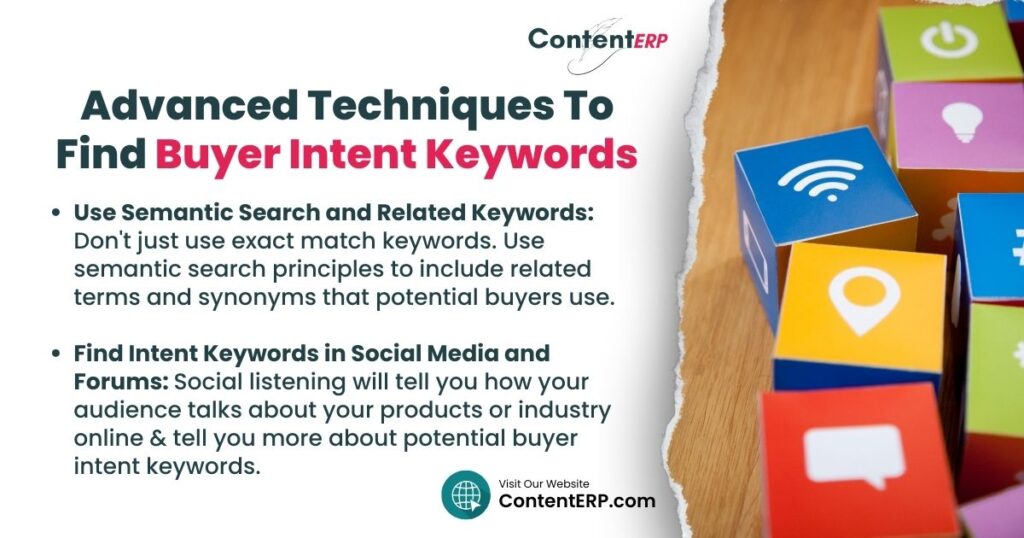
Buyer Intent Keywords List – Top 50 Keywords With Buyer Intent
Now that you all about the buyer intent, let’s give your marketing and content strategy a huge boost with a very effective and tested examples and list of keywords with buying intent with a very customer-centric approach.
- Buy ___ online
- Best deals on ___
- Discount ___
- Purchase ___
- Order ___ cheap
- Affordable ___ for sale
- Promo code for ___
- Sale on ___
- Where to buy ___
- Price comparison ___
- Latest ___ model price
- Buy 4K ___
- Best deals on ___
- Pre-order ___
- ___ subscription discount
- Cheap ___ for sale
- Budget ___ 2024
- ___ review
- Top 10 ___
- Compare ___ prices
- ___ near me
- ___ services cost
- Hire ___ services
- Book ___ appointment
- ___ package deals
- _ subscription promo
- Free trial _
- _ discount codes
- How to install _
- _ solutions for small business
- Professional _ for hire
- _ repair services
- Best _ for beginners
- _ for small spaces
- _ membership benefits
- How much does _ cost
- Is _ worth it
- _ alternatives
- _ warranty extension
- Handmade _
- Vintage _ for sale
- Second-hand _ near me
- _ tutorial for beginners
- How to use _ effectively
- Tips for choosing _
- _ maintenance guide
- Best time to buy _
- How to get a discount on _
- _ clearance sale
- Last-minute deals on __
FAQs on Buyer Intent Keywords
Q: What is an example of keyword intent?
Keyword intent is basically the purpose, the reason for a person to perform a search. Let’s give you an example. “How to fix a leaky faucet” shows an informational intent and suggests that the user perhaps wants guidance rather than a product.
On the other hand, when they’ll search for “buy faucet replacement parts,” it’ll be a clear transactional intent that shows that they may be willing to buy.
Q: What are buying keywords?
Buying keywords are phrases that your audience uses with an intention to buy. Buying keywords have terms like “buy,” “discount,” “deal” or specific product names together with “price” or “review” etc.
Q: How do you identify buyer intent?
One thing you have to know is that buyer intent is NEVER obvious. To identify the buyer intent, you’ll have to understand the language and the context of search. There’s no sure-short way to know otherwise. Here’s what we’ve seen the high-intent keywords to usually include:
- Product-specific names and models.
- Action verbs like “purchase,” “subscribe” or “order.”
Q: How do I find buyer intent keywords?
You can find the buyer intent keywords with SEO tools like SEMrush, Ahrefs or Google Keyword Planner. Use broader and market-related terms first and then narrow them down to specific queries for commercial or transactional intent.
Q: What is an example of buyer intent?
An example of buyer intent is in the keyword “2024 SUV models comparison.” This keyword shows that the user is not just interested in SUVs but is also concerned about their features comparison. This could lead to them buying their preferred vehicle soon.
Q: What is the difference between high intent and low intent keywords?
High intent keywords usually show that your customer may be ready to take action (buy your product or sign up for your service). Here are a few examples: “buy iPhone 15” or “free trial accounting software.”
Low-intent keywords, on the other hand, show that your user may only be looking for more information or general knowledge such as “iPhone 15 features” or “what is accounting software?“
Q: What is an example of a purchase intent?
Let’s give you a classic example of purchase intent with the keyword “best price for wireless headphones.” This keyword shows us that the user has probably already researched about the product he wants and is looking for the best deal. At this time, he is close to the point where he can buy that product.
Q: What is a keyword in selling?
In selling, a keyword is a term that your potential buyers may use when they search for products or services to buy.
Q: What are buying intent keywords examples?
Here are a few examples of buying intent keywords:
- “Discount codes for yoga mats.”
- “Lease deals near me for SUV.”
- “Sign up for online baking classes.”
- “Compare prices for home insurance.”
Conclusion
Buyer intent keywords are the best technique to find your way to your audience’s hearts (and wallets, mind you) and guide them to your product and service. In this article, we have gone through the ‘what’ and ‘how’ of keywords with buyer intent and also highlighted their value and significance to make your marketing strategy a hit instead of a miss.
With such keywords, you won’t just improve your brand awareness but also get attached to your customers on a very personal level with a bond that will ultimately build your brand loyalty. So in this competitive digital marketing world, it is what will transform the people casually browsing through your products your buyers and questions into conversions in the longer run.
Start using these keywords in your strategies today and understand that the online success of your business does not lie in the quantity of traffic but in conversions and connections you’ll create with your audience.

